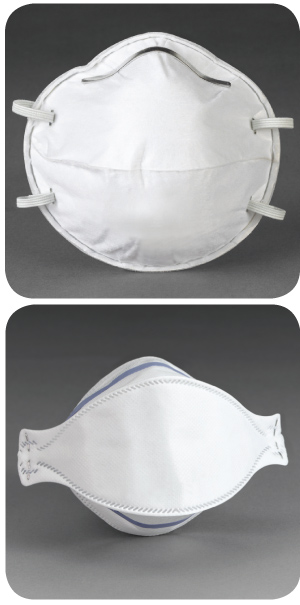For Consumers
Respirators for Public Health Emergencies
 This cup-style respirator (top) and foldable respirator that fits into a pocket or purse closely resemble the first respirators cleared by FDA for public use to reduce exposure to airborne germs during a medical emergency. |
 Get Consumer Updates by E-mail
Get Consumer Updates by E-mail
On this page:
Consumers will soon be able to add a special type of respirator to their home medical emergency kits.
In May 2007, FDA cleared for marketing two respirators that can help reduce a person's exposure to airborne germs during a public health medical emergency. Such an emergency can range from a worldwide outbreak (pandemic) of influenza, to a biological terrorist threat such as anthrax.
The two respirators, manufactured by St. Paul, Minn.-based 3M Company (and called the 3M Respirator 8612F and 8670F), will be available to the general public without a prescription.
How the Respirators Work
Each respirator fits tightly over the nose and mouth to filter out very small airborne particles. The devices are certified as N95 respirators by the National Institute for Occupational Safety and Health (NIOSH). NIOSH uses very high standards to test and certify respirators. The N95 certification means the respirators are designed to filter out at least 95 percent of very small airborne particles. The filter and a proper fit determine the effectiveness of the product.
Many companies make N95 respirators for health care settings and other workplaces. However, the 3M respirators are the first devices to receive FDA clearance for use by the public during public health medical emergencies to reduce exposure to airborne germs. When respirators are used in the workplace, employers provide training and "fit testing" for employees to make sure the respirator fits properly. Because this training is not available to the general public, FDA reviewed data showing how these respirators fit "untrained" adults with a variety of facial sizes, using the provided instructions for putting on the respirator, in order to clear them.
Tips for Using
- The respirators are sized for adults and may not form a proper fit on children.
- Anything that comes between the respirator and the face, such as facial hair, may interfere with its fit.
- People with heart or lung disease may have difficulty breathing through a respirator, and should consult their health care provider before wearing one.
- Wearers should not wash, disinfect, reuse, or share their respirator with others.
- The respirators should be worn once and thrown away after use.
Respirator vs. Surgical Mask
Respirators are not the same as surgical masks. Typically worn by doctors and dentists, surgical masks are loose-fitting and allow air particles to leak in around the edge of the mask. They are designed to help keep potentially infectious droplets from being spread by the person wearing them, and to keep sprays from coughs and sneezes from reaching the mouth and nose of the wearer.
In contrast, N95 respirators are designed to protect a person from breathing in very small particles, which might contain viruses or bacteria. They fit tightly against the face so that most of the air inhaled goes through the filtering material.
Where to Purchase
The respirators will be sold under 3M's Nexcare brand and are expected to be available for purchase mid- to late summer, according to a 3M spokesperson. They will be sold in retail pharmacies and chain stores (mass retailers).
This article appears on FDA's Consumer Updates page, which features the latest on all FDA-regulated products.
Date Posted: June 12, 2007








